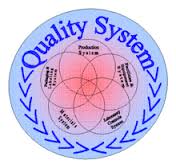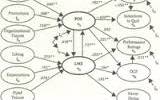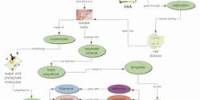INTRODUCTION
Quality control in terms of garment manufacturing, pre-sales and posts sales service, delivery, pricing, etc are essential for any garment manufacturer, trader or exporter. Certain quality related problems, should never be over looked. The consumers want to get high quality products in low price. The products should reach the consumers with right quality depends on the cost. Quality management is the aspect of the overall management function that determines and implements the quality policy. Quality assurance covers all the process within a company that contributes to the production of quality products. The inspection is carried out by representatives of the current production and the result record on control chart. The aim of garment inspection is to visually inspect articles at random from a delivery in order to verify their general conformity and appearance with instruction/description and/or sample received.
METHODOLOGY
At first all the data are collected from different reports and documents of different garment factories. When these data become not sufficient, some other data are collected by close observation and over telephone. This is a descriptive and analytical study. The sample size is 07 (seven). The collected data are processed with MS Excel and all biased & incomplete data deleted from the data bank.
THEORY
Certain quality related problems, often seen in garment manufacturing like sewing, colour, sizing, or garment defects should never be over looked.
Sewing defects
Open seams, wrong stitching techniques, nonmatching threads, missing stitches, improper creasing of the garment, improper thread tension etc. are some of the sewing defects.
Colour defects
Variation of colour between the sample and the final garment, wrong colour combinations and mismatching dyes.
Sizing defects
Wrong gradation of sizes, difference in measurement of various parts of a garment like sleeves of XL size for body of L size garment can deteriorate the garments beyond repair.
Finished garment defects
Broken or defective buttons, snaps, stitches, different shades within the same garment, dropped stitches, exposed notches, fabric defects, holes, faulty zippers, loose or hanging sewing threads, misaligned buttons and holes, missing buttons, needle cuts, pulled or loose yarn, stains, unfinished buttonhole, short zippers, inappropriate trimmings etc. all can lead to the end of a brand name even before its establishment.
Methods of quality control:
Basically two methods are used for garments quality control –
a) Testing
b) Inspection.
Quality Control System is followed by all concerned in the company from piece goods inspection to the final statistical audit.
(1) Piece goods quality control: On receipt of fabrics in the ware house, at least 10% are inspection as per “4 Points” system/10 Points system/2.5 Point system/6.0 Point system. The most commonly used
4 Points system as per below –
SIZE OF DEFECT PENALTY
3 Inches or less 1 Point
Over 3, under 6 Inches 2 Point
Over 6, under 9 Inches 3 Point
Over 9 Inches 4 Point
A maximum of 4 points are changed in one linear yard.
(2) Cutting quality control: In cutting section quality is insure in two stages.
a) Spreading quality control: Following the point are checked during spreading
I. Table marking.
II. Ends
III. Tension
IV. Leaning
V. Narrow Goods
VI. Counts
VI. Ply height
VII. Remnants
VIII. Fabric flaws
IX. Market placing
b) After cutting quality control: After each cutting blocks and bundles are checks on the following points.
I. Mis cut
II. Ragged cutting
III. Pattern checks
IV. Matching Plies
V. Notches
(3) In process quality control (Sewing):
During the swing “In process quality control” is done by the line QC’s through 7 pcs inspection system. For critical operations 100% process inspection are carried out. The following parameters are also checked in sewing process –
a) Machine check.
b) Tension.
c) SPI checks
d) Needle check.
e) Cleanness.
d) Table inspection.
f) Inspection before wash.
(4) Washing section
a) Garments handling
b) Wash standard.
c) After wash thoroughly inspection.
(5) Quality control of finishing sections: Following inspection/audit is done to attain AQL (1.5/2.5/4.0
etc).
a) Process inspection: Garments are checked process wise in the finishing section to identify defects and pass only the passed garments.
b) Two hourly audit: Every after two-hours audit is done on finishing lot to attain AQL the required
AQL.
c) Days final audit: At the end of the day accumulated lot of finished garments are statistically audited to attain required AQL.
d) Lot final audit: On completion of packing of one
complete lot of garment, QA manager conduct statistical audit based on required AQL garments. Garments are offered for final inspection by buyer /clients for shipment only when these are through in this audit. The following parameters are also checked in sewing process–
a) After wash garments must be keep in the box table covering.
b) Thread sucking.
c) Iron inspection.
d) Measurements inspection.
e) Poly inspection of top of garments.
f) Inspection before cartoning.
(6) Testing (Lab test):
a) Shrinkage test
b) Colour fastness. test
c) Azo-free test.
QMS (Quality Management System)
“A set of co-ordinated activities to direct and control an organization in order to continually improve the effectiveness and efficiency of its performance.” Each Quality management systems (TQM, ISO etc) and its elements (Statistical process control, (SPC), Kaizen, Advance product quality planning and control (APQP), have a distinctive applicability. It is necessary that the approach selected suits current and future needs of the organization. SPC works towards bringing process under the influence of common causes alone by identifying & eliminating assignable causes. APQP focuses mainly on new product development/project execution. ISO 9000 currently includes three quality standards (ISO 9000:2005, ISO 9001:2000, and ISO 9004:2000). ISO 9001:2000 presents ISO’s new quality management system requirements, while ISO 9000:2005 and ISO 9004:2000 Present ISO’s new quality management system guidelines. All of these are process standards & not product standards and are developed by quality experts from around the world for use by companies that either want to implement their own in-house quality systems or to ensure that suppliers have appropriate quality systems in place.
Labour intensive industry like apparel can achieve full benefit of QMS only if every individual (Operators and Managers alike) contribute in its implementation.
TQM (Total Quality Management)
TQM is a philosophy or approach to management that can be characterized by its principles, practices, and techniques. Its three principles are customer focus, continuous improvement, and teamwork. Each principle is implemented through a set of practices, which are simply activities such as collecting customer information or analyzing processes. The practices are, in turn, supported by a wide array of techniques.
Successful implementation of TQM requires commitment from top management. No QMS can bring overnight improvements. It is sustained effort towards excellence at each level. Top management should lead by example. This can be demonstrated by top management through active participation in TQM related activates.
Implementation phases of TQM
TQM is a Journey not destination. TQM aim’s at zero defects in each functional areas viz. operations, quality, marketing, utility, service, etc. As the organization progresses from 5- Standards (5-S) –
Daily Work Management (DWM) – Six sigma for each functional area, the possibility of defect rate is reduced to almost zero. Following are the phases of TQM implementation
1) 5-S-(Sort, set in order, Shine, Standardize, Sustain)
- · Foundation Phase
- · Sustenance Phase
- · Maximize plant up time
- · Instrument & system Calibration
- · Break through Improvement
2) DWM (Daily Work Management)
a) Total Productive maintenance (TPM) –
b) Measurement system Analysis (MSA)
3) Six Sigma-
1) 5-S 5-S Defined-Total work culture that develops organization’s ability to the fullest capacity to enhance creativity and eliminate waste. Conceptually 5-S is aimed at developing a work culture where by all employees including operators, supervisors and managers participate in problem solving process.
Sort (1-S) – this is initiated by identifying the abnormalities at the work area. Abnormalities are highlighted by unique identification tag also known as red tag. This ensures every employee participates
in identifying the abnormality in respective work area. It is observed that putting red tag improves awareness regarding the abnormality; it also triggers a reaction among employees to think for ways for avoiding the reoccurrence of abnormality.
Set in Order (2-s) – Efforts are then directed towards resolving the tags. Objective is to find permanent solution to problem. Day to day quality related problems such as label mixing, trims mixing (thread, label wrongly attached) can be completely eliminated through 5-S. Ideally stores should stack trims segregated buyer wise, order wise etc with location marking done for each storage area. This will avoid the instances of wrong trims being issued, even if storekeeping personnel are not available (eliminating human dependency). Secondly segregation of trims on sewing floor/finishing floor size wise, color wise and sizes wise in specially designed boxes, trays with location marked for each, will eliminate any possibility of trim mixing. Not only this (implementing 5-s at stores) reduces the unproductive time (time lost in trims searching) at stores level, but also helps in saving time and improving quality of immediate customers (Sewing Floor). At 2-S Stage (Set in order) it is mandatory to define the inventory level at each stage, this not only applies to stores, but also to sewing, finishing, washing and packing inventory. Defining and controlling WIP has shown marked reduction in stains related rejections, apart from reduction in through put time. It is observed that one basic reason of higher WIP is higher level of rework and alterations. With respect to WIP management aim should be to move towards lean manufacturing with single piece flow. Replenishment of WIP/inventory should be Pull driven rather than push driven.
Shine (3-s) –3-S ensures improved housekeeping by planning, cleaning & Inspection schedules that include floor (Brooming, mopping, vacuum), over headlamps, racks etc. The cleaning schedules should be designed such that it should mention how, when, where, regarding the cleaning activity. It should state the person responsible and accountable for implementing the schedules.
Standardize (4-s)-This refers to standardizing the departmental activities. Here the cleaning schedules, master index (indicating location marked for hard and soft copies/registers), tool list (stating location and quantity) are displayed on notice board. This way human dependency in accessing the records and tools/equipment can be eliminated. Apart from this operational norms for each department are developed. It includes list of incoming material for each department, its desired mode of packing /packaging, packing details, desired mode of transportation of incoming material, material handling equipment for in house movement etc.
These requirements are forwarded to supplier as voice of customer. In addition inventory level for each incoming item with storage locations is planned.
Generally waste (Shaping waste, Empty cones, Threads, Spring cones, polythene, Paper, bamboo etc) is segregated at centralized scrap yard. However ideal method is to segregate the waste at source of generation. To start with, waste can be categorized into organic (Thread, Fabric) and inorganic waste (Polybags, plastic cones etc). Color-coding for dustbins should be done and training imparted to employees to dispose the waste in right dustbin.
Depending on the nature of waste generated by the activity, color coded dustbin is provided at convenient location. Collection of waste from dustbin and disposal of waste to scrap yard should be done by means of similarly colored carts. Method for recovering recyclable waste should also be designed. Sustain (5-s): regular internal and external audits are scheduled to overcome the shortcoming. Time based action plan with responsibility for resolving the abnormality is made.
As the departmental team matures in the problem solving methodology, it is elevated to form Quality circles. Emphasis is to find permanent solution to problem at the work level itself, without elevating the problem to higher level. Sooner the day today issues are resolved at Work area level and managers are free to think regarding improvements. As a rule Managers should spend 80% of his time on improvements. Though the
2) Daily work management (DWM)
Consciously and consistently carryout all activities which must be performed daily (or regularly) to efficiently achieve the aims of each department. In principle, these activities aim to maintain the current status, although activities to improve the situation are also included.
3) Six Sigma
Six Sigma is a business management strategy originally developed by Motorola, USA in 1981. As of 2010, it enjoys widespread application in many sectors of industry, although its application is not without controversy.
Six Sigma seeks to improve the quality of process outputs by identifying and removing the causes of defects (errors) and minimizing variability in manufacturing and business processes. It uses a set of quality management methods, including statistical methods, and creates a special infrastructure of people within the organization („Black Belts”, „Green Belts”, etc.) who are experts in these methods. Each Six Sigma project carried out within an organization follows a defined sequence of steps and has quantified targets. These targets can be financial (cost reduction or profit increase) or whatever is critical to the customer of that process (cycle time, safety, delivery, etc.).
The term six sigma originated from terminology associated with manufacturing, specifically terms associated with statistical modelling of manufacturing processes. The maturity of a manufacturing process can be described by a sigma rating indicating its yield, or the percentage of defect-free products it creates. A six-sigma process is one in which 99.99966% of the products manufactured are free of defects, compared to a onesigma process in which only 31% are free of defects.
DATA ANALYSIS AND FINDINGS Quality control processes of some selected Bangladeshi garments company are as per below –
According to theory, there are different parameters to check or inspect for maintaining quality control and quality management of garments. Besides these, there are also some testing methods are done for keeping the right quality of the garments. From collected data the following things are found –
This study has 07 samples where all the companies follow the 4 point system for inspecting the fabric of garments. These also maintain cutting quality, two hourly audit, and Lot final audit (at presence of buyers’ representatives). Among them 05 (five) companies maintain in process quality control (sewing) by 7 Pcs inspection randomly. All these 07 (seven) factories done process inspection visually and 05 (five) among them maintain days final audit.
Testing such as shrinkage test, colour fastness test, azo free test are done by all these 07 (seven) factories. From the analysis of above data it is seen that every garment factory is maintaining AQL 2.5. Quality management system (QMS) 5’S is used in only 03 (three) factories out of 07 (seven) factories. Six Sigma is used none of the 07 (seven) factories.
Daily work management (DWM) is used in all these 07 (seven) factories.
MAJOR FINDINGS
In Bangladesh most of the garment factories use different tools for quality management but not in organized way. When needs, they use these tools haphazardly.
• In Bangladesh most of the garments factories use 4-point system for inspecting fabrics of garments.
• Most of the buyers are importing garments from Bangladesh with AQL (acceptable level) 2.5.
• Most of the garments manufacturers are doing inspection during the manufacturing process of garments.
• Other tests such as shrinkage tests, colour fastness tests, azo free tests are done according to the buyers’ requirement.
RECOMMENDATIONS
• Every garment factory should implement different tools like 5’S, 6 Sigma etc for perfect quality management.
• As inspection is always visual, sometimes machine can be used for inspection of garments.
• The 4-point system has some limitations so that this system should be used with proper care.
• Every test should be done as per international standard as well as buyer’s requirement.
• Day final audit is very necessary for any production process so that it is needed to implement in every garment manufacturing unit.
• The proper training should be provided for quality related people.
CONCLUSION
In Bangladesh every garments manufacturer should give first preference to its valued customers. Now-adays buyers are very much quality conscious. If it becomes possible to maintain a high Quality system of inspection policy, the buyers shall be motivated to place more orders in Bangladesh. So, it is possible to set different modern quality procedures and quality management techniques in Bangladesh for the betterment of its RMG sector.
REFERENCES
1. An introduction to quality control for the apparel industry Pradip V. Mehta – 1985 .
2. Managing quality in the apparel industry, Pradip V. Mehta, Satish K. Bhardwaj – 1998.
3. Various Methods of Inspection Systems for Apparels; K. Sakthivel, online publication.
4. Garments & Technology; Prof.M. A. Kashem- 2009
5. Garments Merchandising, Prof. M. A. Kashem- 2009
6. Technology of Clothing Manufacture 2nd ed, Harold Carr and Barbara Latham.
7. Garment Technology for Fashion Designers, Gerry Cooklin.
8. TQM: Towards Zero Defects By: C. K. Karekatti http://en.wikipedia.org/wiki/Six_Sigma















